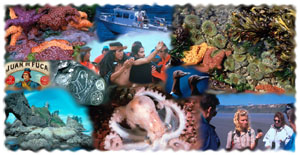|
|
Error processing SSI file |
|
|
|
|
Beneath the waters of its northern margin are productive fishing areas known as "the plain" and Swiftsure Bank. The near shore environment of the sanctuary is one of rugged headlands and cliffs; sea stacks and sea arches; tide pools; hundreds of small offshore islands, rocks, and reefs; and sand and cobble beaches. Sanctuary waters are known for rough seas, large waves, and cold temperatures. Sea surface temperature averages 57 degrees F. in August.
Twenty-nine species of marine mammals, such as harbor seals, harbor porpoises, Pacific white-sided dolphins, Risso's dolphins, and California gray whales, breed, rest within, or migrate through sanctuary waters. The sanctuary contains some of the largest colonies of seabirds such as murres and tufted puffins in the United States. The broad continental shelf area of the northern sanctuary consistently harbors large populations of shearwaters, gulls, murres, and auklets, and the sanctuary coastline is home to one of the largest populations of bald eagles in the lower 48 states. Five species of Pacific anadromous salmon, sea-run cutthroat trout and stealhead, as well as large populations of bottomfish-perch, sole, and cod-are other important components of the sanctuary ecosystem.
Five Native American tribes-the Hoh, Makah, Quileute, Quinault, and Queets once made their homes in the coastal areas near the sanctuary. All but the Queets continue to live there. For centuries each tribe harvested marine mammals, fish, shellfish, and seaweed. Speculation suggests that petroglyphs of whales and other images in boulders at different sites along the shore indicate the importance of the sea's bounty to the area's early inhabitants.
Diving, fishing, wildlife observation and whaling watching are popular recreational uses of the sanctuary. Sport and commercial fishing for salmon, halibut, rockfish, flatfish, cod, crabs, and other shellfish is an important segment of the local economy. Ships carrying fish, lumber, grain, and other cargo traverse the length of sanctuary waters. In addition, over a million people visit the beaches and seaside trails to hike, camp, and go beach combing.
The photo gallery contains images which portray only a small portion of the living and physical resources of the sanctuary. In addition, it portrays some of the major uses of the sanctuary and images of preparations for the 1999 sustainable seas expedition. For a more detailed description of the marvels of the Olympic Coast National Marine Sanctuary visit the Olympic Coast description on the Marine Sanctuaries section of this site.
The
Collection
The Living Sanctuary presents 17 photos depicting marine mammals, fish, birds, and invertebrates. Among these images are sea lions, sea otters, giant pacific sunfish, octopus, dolphin, starfish, rockfish, murrelets, tufted puffin, nudibranches and anemone to name just a few.
Habitats presents 17 photos depicting the various marine and near shore habitats making up the sanctuary. Included in this section you will find rocky intertidal, sandy shore, kelp beds, and other representatives of the diverse habitat making up the sanctuary.
People and the Sanctuary presents 15 images depicting the many ways that human beings use the sanctuary and its adjacent areas. You will see people recreating, researching, harvesting resources, celebrating their cultural heritage, and learning the important lessons that the sanctuary has to offer.
The Sustainable Seas Expeditions includes 32 images of topside submersible training and dive operations in preparation for the June 1999 expedition.
The Kids Gallery contains no entries at this time.

